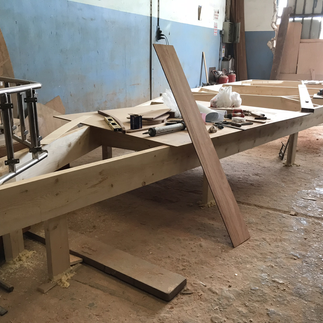On a Wooden Boat….
- Engin Mardin
- Jan 30, 2024
- 4 min read
In this article, Emre Karamancı design and Barbaros Teknecilik production We share the hull construction steps of Ventus 33 and briefly use this example. You will find a brief comparison of wood vs fiber boat?
Wooden boat hull construction
1- Determination of Body Lines;
As the first step, the hull lines are created, and to achieve this, the water contra frames that will later overlap the keel are cut with the help of CNC. Individual pieces consisting of several pieces are combined using the chemical bonding method to form mails. After the water line of each mail is determined, the frames are sewn and sorted. The keel is being built to be placed on the frames.
2- Construction of the keel and stem
After the sections on the frames where the spine will sit are determined and cut, the spine laminated from acajou wood to the required size is placed on the beds of the frames. The reinforced bow post is laminated and combined with the keel to draw a form in line with the hull form.
3- First Planking
Laminated strips of Acajou wood are coated parallel to the waterline. After the first layer of coating, which is joined and adhered with the help of screws, has set, the process ends with removing the screws to prevent corrosion inside and filling the gaps.

4- Second and third coating
After the first coating, light sanding and smoothing is carried out, then it is time for the second layer of coating consisting of 4 mm thick strips. The difference in this coating is that it makes a 45 degree angle with the first coating, and the third coating strips will be positioned at 90 degrees to the second coating. The purpose here is to increase the strength of the laminated strips, because while plywood shows high strength in one direction, it does not show the same strength in the opposite direction. Therefore, in order to provide equal strength in all directions, the second and third coatings are coated at +, - 45 degrees, respectively, compared to the first coating.
The second and third coatings are fixed with plastic staples while they are bonded. After the coatings are frozen, the plastic staples on the outermost layer are removed. And the fiberglass coating process begins.
Although the outermost coating of the underwater line will be fiberglass, an issue that should be noted is that the chemical adhesive used in joining the 3 wooden coatings is epoxy-based and this penetrates into the wood and protects the structure against possible water penetration (intrusion).
5- Hand laid fiberglass coating and epoxy primer application
In order to guarantee that the body will defy the years and to achieve a perfect paint finish at the end, two layers of hand-laid fiberglass were applied to the body to obtain a fiber structure, and several layers of epoxy filler of different consistencies were applied and smoothed to obtain the perfect finish, the last step was A pre-toxic primer was applied.
----------------------------------------------------------------- -------------------------------------------------- --------------------------
The construction process of the wooden body, the most basic steps of which we explained in two minutes, takes approximately 3 months, which does not include preparation processes such as design and material supply.
On the other hand, when you look at mass production boats, the production start and completion period of a boat is roughly 4 to 6 months.
Wooden boats mostly; It is labor-intensive, material-intensive, produced by handcraft in workshops, specifically to order.
There is a reason why this effort was endured...
Wood and fiber comparison,
Wooden boats take longer to build than mass-produced yachts, use more expensive materials, require labor-intensive production, and that's why they cost more. On the other hand, they are known as the most beautiful marine vessels that sail the seas for a long time and are cited with fingers. .
According to the modern understanding that emerged as a result of the development of fiber technology, it is claimed that it is extinct, but as can be seen in our country, many valuable craftsmen (such as Barbaros Boating) continue to produce wooden boats in classical and modern forms upon order from scratch and manage to gain the satisfaction of their customers.
Wooden boats have both hot & Cold weather thermal insulation, sound insulation and machine vibration absorption are among the points considered superior to fiber boats. Hull sprains and durability are respectively less and stronger than fiberglass, and electrification caused by hull and sea friction during long cruises is also less.
Fiberglass boat production and wooden boat production are both valuable crafts, but if we ask which material you like to touch more, the warmth created by the fact that wood comes from nature and the smell that reminds you of yourself when you enter the boat can be considered an important reason for choosing wood.
The routine maintenance of a wooden boat undoubtedly requires more attention than a fiberglass boat, whereas wood is a material that has proven itself from past to present and can withstand water for many years without requiring major repairs.
As in every field, there are pros and cons of wood compared to a fiberglass yacht, so we hope this article has opened a window in the minds of potential buyers who are sympathetic to the cruising type wooden boat.
Stay safe
Engin Mardin




































Comments